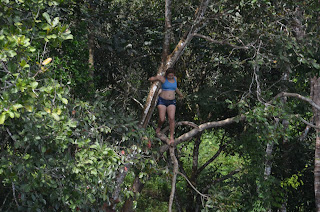While in Panama we went out as much as we could and when we had a good tour guide they would fill our travelling time from location to location with not only facts about the country but with little insights from their own lives
That's how you learn about people, form their own stories.
This day was our last day in Panama and it was our getaway day, we would be on our way to the airport by 1 pm. Oh yeh, it was also New Years Eve. Collette had woken up with a bit of a cold so she decided to nap while I went for one last stroll around the resort, which comprises most of the video.
It was the hottest day so far in Panama so of course, I kept myself cool with a few margharita's .. by 10 am
But I didn't really want to discuss my nascent tropical alcoholism, I wanted to post some final thoughts and impressions of Panama.
Here are a few of our favourite memories from this amazing little country
DIABLO ROJO:
It means Red Devil. And it refers the the traditional buses of Panama. The country has a very good road system, it's where the Pan American highway essentially end. Compared to Costa Rica and Belize the highways are quite good. The bus system is very good. You can go pretty much anywhere in the country by bus and it's fairly cheap. Traditionally the buses they used were big old school buses, not all comfortable from what I understand but quite something to look at.
The Diablo rojo's are painted in bright garish colours, traditionally by their owners and often reflecting that person's point of view, from politics to pulp culture to politics. It was though the colourful and personalized artwork could make up for the rough ride.
These buses are often being replace now by more modern, comfortable buses and the school buses are more often being "wrapped" in some form of advertising rather than being custom painted, but the rojo's are still rolling and they were something that gave us some flavour of Panama's personality
NEW YEARS MANNEQUINS:
As we were being driven around the country we kept noticing something odd: Mannequins, full sized dolls, put out by the road. Sometimes alone, sometimes in groups, fully dressed and made up. A few were superheroes, I saw a Reagan, most I would learn later they were local celebrities and politicians
For instance, here is the president of Veneziela and his companion
We couldn't figure out what this was all about until it was explained to us: The puppets are made by locals and put out as part of the New Years celebration, they are usually put out a week or so before. The dolls are stuffed with fireworks and on New Years Eve they are set up; you can drive up and down the roads and watch these hundreds of dolls blowing up. Unfortunately we flew out of the country before we could witness that but I just loved this idea.
THE CANAL:
The situation with the canal is a fascinating one. For a long time, a hundred years, the fate of this country revolved around something over which it did not even have control. The French began the canal, the Americans finished it and they controlled it for a long time. It's only been about 15 years that Panama has had total control of the canal and thereby, it's own destiny.
One our tour guides phrased it as Panama being one of the newest countries on earth. Columbia controlled Panama before the canal, and it wasn't the French of the Americans it was like dictators like Noriega. Now Panama rules the canal, and rules itself. The striking skyline of Panama city is one byproduct of these events, very few of the skyscrapers are more than fifteen years old
It's fair to say that the destiny of the country is tied to the canal. They are building a new one, new sets of locks, to accomodate larger ships. They are building a new airport, subway etc. In the country it looks like life is unwinding the way it has for a very long time. People live off the land, they follow old traditions; they enjoy health care and education that stems from the canal but at this point I don't know if they see the future the same as do those in the city.
Tourism is playing a larger role as well, particularly eco tourism. Panama still has a large amount of protected rainforest and beaches. Will that continue as the need to industrialize continues? I can't say, but when I think of Panama I will recall warm sand under my toes, warm ocean water over my head, the sound of the forest, the feeling of a water fall on my back, and smiling young women selling me home made candy from a road side stall.
Here's the video
























































